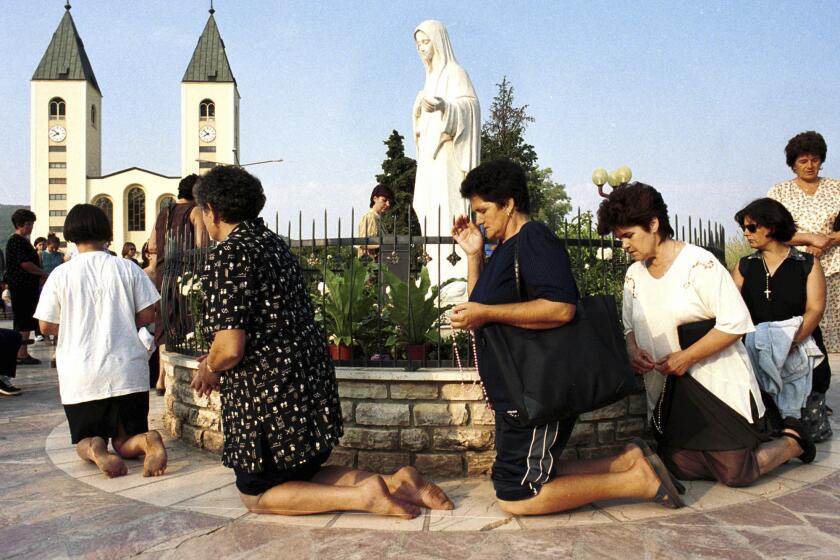Injuries to Guards Rise Along With Juvenile Hall Violence
It was a Saturday afternoon and the teen-age inmates were playing cards in a sparsely furnished housing unit at Ventura County’s juvenile hall, the Clifton Tatum Center.
Suddenly, one gang member accused another of cheating and the pair began throwing punches.
Paul Pena, a 240-pound corrections officer, hit the panic alarm and threw his arms around one flailing inmate. As his partner, Rudy Lopez, pried the other away, one youth crashed against Pena’s right hand, breaking his wrist and thumb.
“After that, my hand swelled up like a big balloon,” said Pena, 25. “It got black and blue and I didn’t return to work for four months.”
Corrections officials say they don’t know how much such injuries at the Clifton Tatum Center in Ventura are costing the county, but the number has jumped sharply over the past year. Those who have been hurt say the injuries are a sign that the teen-agers they work with are growing more violent and less fearful of being punished for misconduct.
Workers at juvenile hall have reported 51 injuries this year, where only 26 were reported in 1992. Before that, there were 23 in 1991 and 21 in 1990.
That rise is also reflected in the total number of medical claims from employees of the Corrections Services Agency, which runs juvenile hall, along with the probation department and other facilities.
In the 1992-’93 fiscal year, the department had 24 cases that required significant medical care, at a cost of $44,592--up from nine claims the year before. And already since July 1, there have been 17 claims costing $28,996 in medical bills and time off.
As evidence of how seriously corrections officials are taking the problem, they have hired a private consultant to teach self-defense to both full- and part-time officers at juvenile hall. And, for the first time, they have authorized the staff there to use a cayenne pepper-based spray to disable violent inmates.
“What we’re hoping is to quell even the start of these fights,” said Frank Woodson, director of the county Corrections Services Agency.
The majority of injuries inside juvenile hall, officials say, occur as guards try to break up fights sparked by allegiance to gangs, or occasionally by racial comments.
Raymond DeLosSantos, who has been in juvenile hall 13 times since the age of 13, said fights can start, unpredictably, from nothing more than eye contact between rival gang members. Other times, it is more difficult to pin down the trigger.
“Sometimes they’ll, like, look at each other weird--mad-dogging,” he said. “Maybe if they see each other on the outs . . . maybe they saw each other and maybe they didn’t like each other.”
DeLosSantos, who is 18 and lives in Ventura, said fights inside the hall can boost a gang member’s reputation.
“Maybe these guys would be happy this person is fighting. They’ll be like, ‘He’s all cool.’ Everybody will talk about it in there,” he said.
The most common injuries occur when corrections officers wrench their shoulders and knees as they crash to the linoleum-covered floor wrestling with minors. And although many injuries are less serious--a bruised shin, a strained back, a sore jaw--four employees have had to undergo surgery and spend several months off work.
Chuck Walker, 25, had part of his shoulder removed and the bone shaved down to keep his nerves from being pinched. Walker suffered his injury in May while breaking up a fight between three gang members. Twice during the scuffle, his shoulder was slammed against a stone wall.
Walker said he hopes to return to work in late January or early February. “Right now, it’s just kind of wait and see.”
And Pena still has a scar on his right hand where he had surgery. Even before he hears a weather forecast, an ache in his thumb tells him it’s about to pour.
Despite the growing risks of their jobs, corrections officers at juvenile hall say the county has not done all it could to protect them. They say the facility itself is outdated and staffed at minimum levels, and that they have not been given proper training and equipment.
“If we’d had O.C. (pepper spray) a year ago--when all the other institutions (across the state) were starting to incorporate it--we wouldn’t have the amount of staff injuries we have,” Walker said.
“I think we need to be viewed more as peace officers in the institution and not baby sitters or group supervisors or counselors of a sort,” he added.
But administrators of the Corrections Services Agency defend the department’s training programs, saying officers have had courses in self-defense along with instruction on first aid, counseling and gang awareness. Administrators also say that when the injuries began to increase, they took steps to protect the staff and juveniles.
“I think we moved on that as soon as we realized there was a problem,” said Cal Remington, deputy director of the county corrections department. “When we have people incarcerated, one of our goals is to provide a safe place for people to be.”
Built in phases during the 1950s and early 1960s, the white two-story building on Hillmont Street in Ventura has four residential units and 84 beds. At times, the population swells to more than 115 minors, although it is low at this time of year. Given the limited number of housing areas, officials say it is nearly impossible to separate all the violent youths from rival gangs.
The facility’s population is constantly changing. Minors can stay there as briefly as a few hours or up to several months as they await sentencing or placement in another facility.
When an alarm goes off, staff members rush to the housing unit where there is trouble, leaving just one staff member in each of the other units to lock up 16 to 20 youths.
“We don’t have any other options except for hands to restrain these people, and that’s why everybody’s getting hurt,” Walker said.
Ron Martinelli, a former San Jose police officer who now runs a firm providing law enforcement training, said one way the county could reduce staff injuries is by telling guards not to jump into fights so quickly.
“I’d rather let the kids fight against each other, and let them get pooped out, before an officer jumps in,” he said. “When an officer jumps in by himself to break up a fight, he’s the one that gets injured most often.”
Martinelli said the inmates are sometimes in better shape than the officers and are less likely to get injured. County officials say serious injuries among inmates are rare and only a handful have required medical treatment this year.
Some corrections officers say it will be difficult for them to follow Martinelli’s advice. They say they feel responsible for the safety of the inmates they supervise.
“We’re programmed that if a fight goes down, we’re getting up to break it up,” said Ernie Robleto, a supervisor in juvenile hall who has been injured twice during the past two years. “It’s like an unwritten law that that’s what you do.”
But, Martinelli said, the old way of doing things doesn’t work with the kind of teen-agers filling juvenile hall today.
Of the 59 boys and five girls in custody this week, 21 are there for violent offenses, including two for murder, three for assault with a deadly weapon and five for robbery.
Seven allegedly committed serious drug offenses, including selling on school grounds. Thirteen were booked for burglary and stealing cars. And 13 violated the terms of their probation.
Juvenile hall no longer accepts minors accused of shoplifting or petty theft, unless they have extensive records for other crimes. And runaways have not been housed there since the 1970s.
“Once they’re here and going to the (California) Youth Authority for 10 to 15 years, they know they have nothing to lose,” said corrections Officer William Hislop as he surveyed a room crowded with 30 boys, some of whom were displaced from another unit because of repair work.
Corrections officials say the new defensive training and the pepper spray are necessary tools because of the kind of minors they are dealing with.
“With the violence and number of crimes among teen-agers going up, we’re having to catch up with the idea that these kids commit real serious offenses and that they hurt people,” said Betty Van Order, the interim manager of juvenile hall.
Woodson, the county’s top corrections official, added: “The basic mission hasn’t changed. But the emphasis we have to put on safety and security seems to have heightened over the last year.”
Across the street from juvenile hall sits Frank A. Colston Youth Center, a smaller facility where less-violent teen-agers are placed in an intensive counseling program. Colston sees only a fraction of the violent outbursts as juvenile hall, although corrections officers at both facilities receive the same training.
Lopez said the difference between the institutions should be reflected in the training of corrections officers.
“They don’t get physical with kids over there. We get physical,” said Lopez, referring to the work of corrections officers.
When hired, all corrections officers attend a one-month, state-mandated training course. Beyond that, they attend 24 hours of training each year on a wide range of subjects.
Part-time corrections officers, who work up to 50 hours a week, receive even less training. Their only requirement is an eight-hour self-defense course when hired, although some will attend Martinelli’s course in February.
Overall, Martinelli said, county corrections and probation officers throughout the state typically receive about one-third the training of sworn police officers.
“Yet they are dealing with the same people, and dealing with them in more confined quarters and under riskier circumstances,” he said.
Those who have had Martinelli’s training--it is being given in groups of 20 and should be finished by February--have praised it for simulating real-life scenarios.
Corrections officers are taught to shout verbal commands and physically subdue minors as instructors attack them wearing heavy padding.
Juvenile hall employees say they believe the training combined with the pepper spray will cut down on fights and improve the atmosphere there. But they also say those measures are just a starting point.
They want more unarmed, use-of-force training--something Woodson said is already planned. And above all else, officers want a bigger juvenile hall with more built-in security measures.
“What we need is a brand-new facility,” said Pena. “There’s only so many Band-Aids you can put on a wound. It’s still going to bleed, and that’s what this facility is doing.”
Woodson said a group of top county officials discussed in November the need for a new juvenile hall--which could cost from $10 million to $20 million--and other facilities. However, statewide bond measures for such facilities have failed in recent years and the county has no plans now for how to pay for one.
“That’s the big question mark,” Woodson said.
More to Read
Start your day right
Sign up for Essential California for news, features and recommendations from the L.A. Times and beyond in your inbox six days a week.
You may occasionally receive promotional content from the Los Angeles Times.






